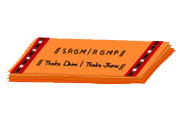Posted By: Administrator
Rāga: Gambhīranāṭṭai
Thāḷa: Khaṇḍa Chāpu
Composer: Ūthukkāḍu Vénkaṭasubbaiyyar
Language: Sanskrit
Meaning –
Word by word: Team Ambalam
Meaning –Overall: forum hub
Alignment, Diacriticals & consequent spelling changes,
Language & grammar editing, if any and necessary, of existing meaning: Team
Ambalam
Pallavi
Śhrī Vighna Rājam Bhaje- Bhajeham
Bhajeham
Bhajeham Bhaje - Thāmiha
(Śhrī Vighna)
Anupallavi
Santhathamaham Kunjaramukham
Śhankarasutham Śhankari Sutham - Thāmiha
Santhathamaham Dhanthi
Sundhara Mukham - Antha
Kanṭhaka Sutham - Śhiva
Śhankari Sutham - Thāmiha
Charaṇam 1
Sevitha Surendhra Mahanīya Guṇaśhīlam
Japatha Samādhhi Sukha Varadha - Anukūlam
Bhavitha Suramaṇi Gaṇa Bhaktha Paripālam
Bhayankara Viṣhaṅga Māthaṅga Kulakālam
(Śhrī Vighna)
Charaṇam 2
Kanaka Keyūra Hārāvaḷi Kalitha
Gambhīra Gowragiri Śhobham Suśhobham
Kāmādhi Bhaya Bharitha Mudha Madha
Kalikaluṣha Kanṭhitham Akhanda Prathāpam - Prathāpam
Sanaka Śhukha Nāradha Pathanjali Parāśhara
Mathaṅga Munisaṅgha Sallāpam - Sallāpam
Sathya Paramabja Nayanapramudha Mukthikara
Thathvamasi Nithya Nigamādhi Swarūpam
(Śhrī Vighna)
Meanings:
Pallavi
Śhrī Vighna Rājam Bhaje- Bhajeham Bhajeham
Bhajeham Bhaje - Thamiha
(Śhrī Vighna)
Śhrī Vighna Rājam – the lord Gaṇeśha;
Bhaje- bow
to;
Bhajeham Bhajeham – Bhajeham Bhaje - I bow to;
Thamiha – to him here
(Śhrī Vighna)
I bow to lord Ganeshā.
Verily, I seek refuge in that lord who is the remover of all obstacles.
Anupallavi
Santhathamaham
Kunjaramukham
Śhankarasutham Śhankari Sutham - Thāmiha
Santhathamaham Dhanthi
Sundhara Mukham - Antha
Kanṭhaka Sutham - Śhiva
Śhankari Sutham - Thāmiha
Santhatham aham
– always I;
Kunjaramukham – the elephant faced one;
Śhankara sutham – the son of Śhiva; Sutham - son
Śhankari Sutham –the son of Pārvathi;
Thamiha - to him here;
Santhathamaham - always I;
Dhanthi – the tusk;
Sundhara Mukham – beautiful faced one;
Andhakānthaka Sutham – the son of the destroyer of the demon Andhaka
Ever I beseech him who bears the head of an elephant; Who is the
son of lord Śhankara
(the destroyer of the demon Andhaka) and devi Śhankari/Parvati.
Charaṇam 1
Sevitha
Surendhra Mahanīya Guṇaśhīlam
Japatha Samādhhi Sukha Varadha - Anukūlam
Bhavitha Suramaṇi Gaṇa Bhaktha Paripālam
Bhayankara Viṣhaṅga Māthaṅga Kulakālam
(Śhrī Vighna)
I pray to him) who is worshipped by Indira-the
foremost among the suras/devas; Who is the abode of virtues;
Who grants boons to his devotees (who approach him through
recitation & penance-culminating in Samādhhi);
Who is meditated upon by devas, rishis & other
devotees; Who is the cause of destruction of poisonous evil (personified as a
mad elephant)*
Charaṇam 2
Kanaka
Keyūra Hārāvaḷi Kalitha
Gambhīra Gowragiri Śhobham Suśhobham
Kāmādhi Bhaya Bharitha Mūḍha Madha
Kalikaluṣha Kanṭhitham Akhanda Prathāpam - Prathāpam
Sanaka Śhukha Nāradha Pathanjali Parāśhara
Mathaṅga Munisaṅga Sallāpam - Sallāpam
Sathya Paramabja Nayanapramudha Mukthikara
Thathvamasi Nithya Nigamādhi Swarūpam
(Śhrī Vighna)
Kanaka Keyūra Hārāvaḷi Kalitha - who is bedecked
with ornaments of gold
Gambhīra – vigilant;
Gaura giri - the white mountain, Kailāsa
Śhobham - the adornment of;
Suśhobham - resplendent
Kāmādhi – lust etc.; Bhaya – fear;
Bharitha – full of; Mūḍha – not
rational;
Madha – arrogance;
Kalikaluṣha – sin, dirt;
Kanṭhitham – enemy;
Akhanda Prathāpam – all powerful; (Prathāpam)
Sanaka Śhukha Nāradha Pathanjali Parāśhara Mathaṅga Muni – names of all sages;
saṅga – with;
Sallāpam – happy moments; (Sallāpam)
Sathya Paramābja - the sea of truth ;
Nayanapramudha – the lotus eyed;
Mukthikara- bestower of salvation
Thathvamasi – you are that;
Nithya – eternal;
Nigamādhi Swarūpam - embodiment of the ultimate
truth
(Śhrī Vighna)
I pray to him, who is bedecked with
ornaments of gold, that ever vigilant lord, Who is the adornment of Kailāsa; Who
is the antithesis of lust (kāma), Arrogance (madha), irrationality (mūḍha) and
who dispels fear/bhaya( as he is the all-powerful, courageous one; Who is
praised by saints like Sanaka, Śhuka, Nāradha,
Pathanjali, Parāśhara and Mathaṅga; Who is the embodiment of the ultimate truth
and bestower of salvation-verily I bow to that lotus-eyed lord!
Note: Often Vāggeyakāras(composers) portray
sin/pāpa as a wild elephant-who is out of control. The godhead represents a
counter-force to destroy this mad elephant of sin. Another instance is in
'jagadhānandakāraka' (Thyāgarāja's first Pancharathna in nāṭa) wherein the last
charaṇa describes Śhrī rāma as 'pāpagaja nrisimha'or the lion (pun on Viṣhṇu's
Narasimhāvathāra also here!) Who destroys the 'mad elephant’ of sin. In fact as
I translate this I find a very fine imagery centered around the elephant (mathanga/kunjara)
in this kīrthana. Lord Ganeśha is indeed 'kunjara-mukha'; in the phrase māthaṅgakula
kāla -the image of a wild elephant, representing sin and finally you find the
term 'māthaṅga' as the name of māthaṅga muni.












